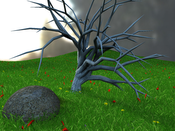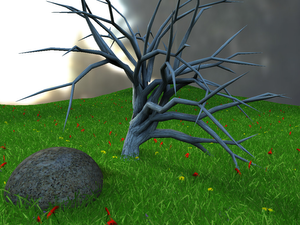Information
- Publication Type: Journal Paper with Conference Talk
- Workgroup(s)/Project(s):
- Date: January 2007
- Journal: Journal of WSCG
- Volume: 15
- Number: 1-3
- Note: ISBN 978-80-86943-00-8
- Location: Plzen, CZ
- Lecturer: Ralf Habel
- ISSN: 1213-6972
- Event: WSCG
- Conference date: 29. January 2007
– 2. February 2007
- Pages: 123 – 128
- Keywords: Real-time Rendering, Natural Scene Rendering, Natural Phenomena, GPU Programming
Abstract
This paper introduces a technique for rendering animated grass in real time. The technique uses front-to-back compositing of implicitly defined grass slices in a fragment shader and therefore significantly reduces the overhead associated with common vegetation rendering systems. We also introduce a texture-based animation scheme that combines global wind movements with local turbulences. Since the technique is confined to a fragment shader, it can be easily integrated into any rendering system and used as a material in existing scenes.
Additional Files and Images
Additional images and videos
Additional files
Weblinks
No further information available.
BibTeX
@article{Habel_2007_IAG,
title = "Instant Animated Grass",
author = "Ralf Habel and Michael Wimmer and Stefan Jeschke",
year = "2007",
abstract = "This paper introduces a technique for rendering animated
grass in real time. The technique uses front-to-back
compositing of implicitly defined grass slices in a fragment
shader and therefore significantly reduces the overhead
associated with common vegetation rendering systems. We also
introduce a texture-based animation scheme that combines
global wind movements with local turbulences. Since the
technique is confined to a fragment shader, it can be easily
integrated into any rendering system and used as a material
in existing scenes. ",
month = jan,
journal = "Journal of WSCG",
volume = "15",
number = "1-3",
note = "ISBN 978-80-86943-00-8",
issn = "1213-6972",
pages = "123--128",
keywords = "Real-time Rendering, Natural Scene Rendering, Natural
Phenomena, GPU Programming",
URL = "https://www.cg.tuwien.ac.at/research/publications/2007/Habel_2007_IAG/",
}
 grass_screenshot:
grass screenshot
grass_screenshot:
grass screenshot


 Preprint
Preprint